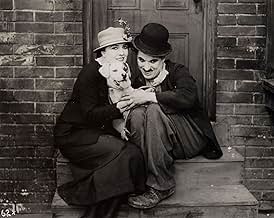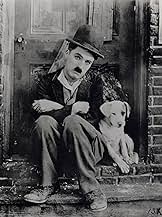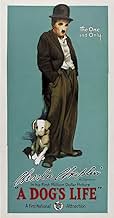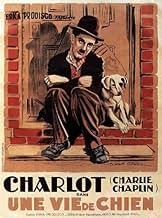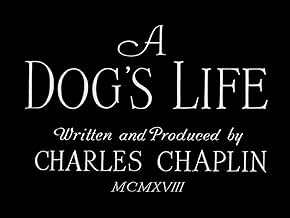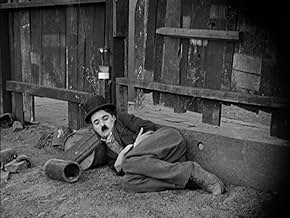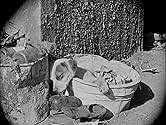PUNTUACIÓN EN IMDb
7,6/10
10 mil
TU PUNTUACIÓN
Añade un argumento en tu idiomaThe Little Tramp and his dog companion struggle to survive in the inner city.The Little Tramp and his dog companion struggle to survive in the inner city.The Little Tramp and his dog companion struggle to survive in the inner city.
- Dirección
- Guión
- Reparto principal
Edna Purviance
- Bar Singer
- (sin acreditar)
Dave Anderson
- Bartender
- (sin acreditar)
Bert Appling
- Unemployed Man
- (sin acreditar)
Albert Austin
- Crook
- (sin acreditar)
Henry Bergman
- Fat Unemployed Man
- (sin acreditar)
- …
Alva D. Blake
- Man in Dance Hall
- (sin acreditar)
Mel Brown
- Employment Agency Clerk
- (sin acreditar)
- …
Minnie Chaplin
- Dance-Hall Dramatic Lady
- (sin acreditar)
Syd Chaplin
- Lunchwagon Owner
- (sin acreditar)
Dorothy Cleveland
- Woman in Dance Hall
- (sin acreditar)
Slim Cole
- Unemployed Man
- (sin acreditar)
Margaret Cullington
- Woman in Dance Hall
- (sin acreditar)
Billy Dill
- Man in Dance Hall
- (sin acreditar)
Margaret Dracup
- Woman in Dance Hall
- (sin acreditar)
Jack Duffy
- Man in Dance Hall
- (sin acreditar)
Robert Dunbar
- Old Man in Dance Hall
- (sin acreditar)
Ella Eckhardt
- Woman in Dance Hall
- (sin acreditar)
Reseñas destacadas
Just like his little tramp alter ego, Charlie Chaplin liked to think big, and had always aimed to extend the scale and scope of his pictures, never content to be a two-reel sideshow. At 35 minutes, A Dog's Life could hardly be described as his first full-length feature, but it arguably represents his break away from shorts.
Just the opening shot of A Dog's Life shows how Chaplin is starting to inject some grand sweep into his storytelling. The camera begins amid city rooftops, tilting down to reveal Charlie sleeping amid the rubbish behind a ramshackle fence. The way this purpose-built set is shot demonstrates how Chaplin was as much a "proper" director as a comic. He several times has a shabby sign advertising "rooms" visible in the background – a subtle reminder that the tramp is too poor even for the cheapest accommodation.
It's a nice touch how Charlie's canine friend is introduced in a handful of cutaways during this opening scene – treating him as a real character rather than just a plot device. But this is not to the detriment to his human companions, and indeed leading lady Edna Purviance gets a more substantial part than she did in many of the shorts. She makes a really great character here, giving an impression of a naïve but feisty youngster, certainly more than just a token female. It's this kind of characterisation that gives A Dog's Life the kind of comprehensive structure of a feature film, as opposed to a comedy short in which people just turn up on screen for a bit of funny business.
On a quick side-note, this is the earliest Chaplin picture which features a score written by him (although since he wrote the music in retrospect some decades later it's not the first he wrote). It's another testament to the breadth of his genius, showing both considerable musical ability as well as his own irreverent personality. Numbers like the dance hall rag are of course very "silent comedy", but pieces like the opening theme have a truly deep and epic feel to them. Even here though, the Chaplin cheekiness shines through, with different parts of the orchestra playing off each other in a kind of question-and-answer routine.
Chaplin would repeat this "little companion" routine, swapping dog for tot in his first genuine full-length feature The Kid. A Dog's Life remains a worthy predecessor, part of the comedian's ever upward trajectory at this point in his career. It would take more battling with studio heads for Chaplin to get his ideas fully realised, but it was pictures like this that began to get silent comedy taken seriously.
Just the opening shot of A Dog's Life shows how Chaplin is starting to inject some grand sweep into his storytelling. The camera begins amid city rooftops, tilting down to reveal Charlie sleeping amid the rubbish behind a ramshackle fence. The way this purpose-built set is shot demonstrates how Chaplin was as much a "proper" director as a comic. He several times has a shabby sign advertising "rooms" visible in the background – a subtle reminder that the tramp is too poor even for the cheapest accommodation.
It's a nice touch how Charlie's canine friend is introduced in a handful of cutaways during this opening scene – treating him as a real character rather than just a plot device. But this is not to the detriment to his human companions, and indeed leading lady Edna Purviance gets a more substantial part than she did in many of the shorts. She makes a really great character here, giving an impression of a naïve but feisty youngster, certainly more than just a token female. It's this kind of characterisation that gives A Dog's Life the kind of comprehensive structure of a feature film, as opposed to a comedy short in which people just turn up on screen for a bit of funny business.
On a quick side-note, this is the earliest Chaplin picture which features a score written by him (although since he wrote the music in retrospect some decades later it's not the first he wrote). It's another testament to the breadth of his genius, showing both considerable musical ability as well as his own irreverent personality. Numbers like the dance hall rag are of course very "silent comedy", but pieces like the opening theme have a truly deep and epic feel to them. Even here though, the Chaplin cheekiness shines through, with different parts of the orchestra playing off each other in a kind of question-and-answer routine.
Chaplin would repeat this "little companion" routine, swapping dog for tot in his first genuine full-length feature The Kid. A Dog's Life remains a worthy predecessor, part of the comedian's ever upward trajectory at this point in his career. It would take more battling with studio heads for Chaplin to get his ideas fully realised, but it was pictures like this that began to get silent comedy taken seriously.
This film was one of three that were later combined by Chapin into a compilation that was released to theaters in the late 1950s under the title "The Chaplin Review".
Of the three films combined for The Chapline Review, this is probably the most familiar in style and, to me, the least interesting. While it is STILL a very good film, it just didn't seem all that new or different. We have the Little Tramp down on his luck and looking to feed himself when he stumbles upon a poor lonely dog being picked on by the other dogs. So, he adopts it and they both set out on some adventures. I know this may sound strange, but to me this film felt a lot like an earlier incarnation of THE KID--though of course in this case it's a cute mutt and not Jackie Coogan. A very good and entertaining short with no serious flaws.
Of the three films combined for The Chapline Review, this is probably the most familiar in style and, to me, the least interesting. While it is STILL a very good film, it just didn't seem all that new or different. We have the Little Tramp down on his luck and looking to feed himself when he stumbles upon a poor lonely dog being picked on by the other dogs. So, he adopts it and they both set out on some adventures. I know this may sound strange, but to me this film felt a lot like an earlier incarnation of THE KID--though of course in this case it's a cute mutt and not Jackie Coogan. A very good and entertaining short with no serious flaws.
By the time he made `A Dog's Life', Charlie Chaplin was already a master of cinematic comic timing. Editing techniques had not developed to the point at which they would be much help to Chaplin's physical comedy gags, so laughs required expertly handled choreography. Chaplin must have rehearsed countless takes to get each scene just right. The incredible opening sequence, seemingly shot all in one take, is particularly amazing. Chaplin and his fellow actors synchronize their movements perfectly so that, no matter what action they undertake, they always arrive on opposite sides of the fence at the exact same moment. Additionally, they make each movement at a natural pace so that, rehearsed though they may be, their motions always seem spontaneous and believable. You never get the sense that Chaplin or the policemen are speeding up or slowing down.
Rating: 6.5
Rating: 6.5
This is an entertaining comedy with a couple of particularly amusing scenes. Chaplin is joined by several of his regular supporting players like Edna Purviance and Henry Bergman, plus Syd Chaplin, and the cast works together well. The story is funny, yet not without some substance either.
As his usual 'tramp' character, Charlie is already living "A Dog's Life" when he befriends a stray dog, and they share some adventures together. Chaplin hits a good balance in keeping himself and the dog sympathetic without overdoing the sentiment. There are some slow stretches that keep it from being even better, but the good parts make up for them and make this definitely worth watching. One particular highlight is a scene where Charlie tries to outwit two thieves - it's very cleverly done and very funny.
Anyone who likes Chaplin's comedies should enjoy this one. It has good comedy, a talented and familiar cast, and some worthwhile material - just about everything you would expect in one of Chaplin's features.
As his usual 'tramp' character, Charlie is already living "A Dog's Life" when he befriends a stray dog, and they share some adventures together. Chaplin hits a good balance in keeping himself and the dog sympathetic without overdoing the sentiment. There are some slow stretches that keep it from being even better, but the good parts make up for them and make this definitely worth watching. One particular highlight is a scene where Charlie tries to outwit two thieves - it's very cleverly done and very funny.
Anyone who likes Chaplin's comedies should enjoy this one. It has good comedy, a talented and familiar cast, and some worthwhile material - just about everything you would expect in one of Chaplin's features.
Of Charlie Chaplin's many works, "A Dog's Life" is in my top 5, under "The Kid", "City Lights" and "Modern Times". Though just a short, I think this film is one of Chaplin's funniest and most poignant of them all. It had me laughing the whole time and this is the film that made me fall in love with his hands: It was the miming scene where the Tramp has to pretend to be the bully he's just knocked out, to get the wallet back, simply by using hand gestures! It's a moment that shines for all silent movies, showing how little sound is needed to communicate - it's a favorite scene of mine. This is a great film, and especially when coupled with "The Kid" (Chaplin's best work, I think, and my favorite film of all time) how could *anyone* refuse?
¿Sabías que...?
- CuriosidadesThis was Charles Chaplin's first film for First National Pictures under a $1M contract where Chaplin had full creative control over his films for the first time.
- PifiasDuring the fight at the lunch cart, one of the props holding up the awning gets knocked away. In subsequent shots, the prop is back in place.
- Citas
Title Card: When dreams come true.
- ConexionesEdited into La revista de Chaplin (1959)
Selecciones populares
Inicia sesión para calificar y añadir a tu lista para recibir recomendaciones personalizadas
Detalles
- Duración33 minutos
- Color
- Mezcla de sonido
- Relación de aspecto
- 1.33 : 1
Contribuir a esta página
Sugerir un cambio o añadir el contenido que falta

